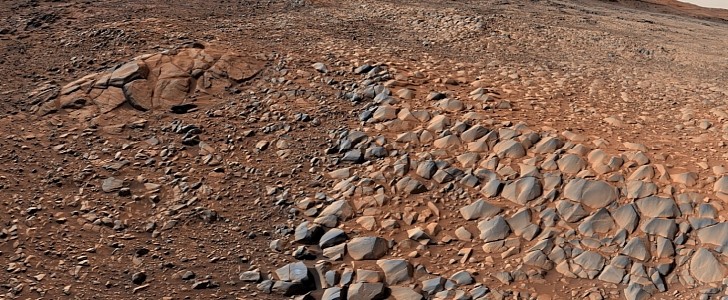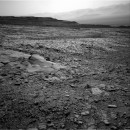NASA's Curiosity rover has been exploring our cold, red neighbor for almost a decade. Over the years, the rugged Martian terrain has taken serious bites out of the rover's wheels. So Curiosity must tread carefully while deciding where to go next.
While investigating a sloping plain in the foothills of Mount Sharp on Mars, Curiosity has encountered patches filled with wind-sharpened rocks, known as ventifacts.
Because of their scaly appearance, scientists have nicknamed them "gator-back" rocks. They are the same types of rocks that chewed up the machine's already damaged wheels earlier in the mission.
The rover has taken several images that show the ventifacts up-close. This allowed the team behind Curiosity to determine that they are made of sandstone, which is the hardest type of rock the rover has found on Mars.
Because continuing up the slope would've been far too dangerous for Curiosity, the team has decided to map out a new course for the rover as it continues to explore Mount Sharp, a mountain that stands about 3 miles (5 km) tall. Curiosity's findings reveal that Mount Sharp was formed by sediments accumulated in a large lake bed over billions of years. By studying these rock layers, scientists can better understand if ancient microbial life could have persisted in the Martian environment.
In the following weeks, Curiosity will take an alternate path to explore a terrain that has clay-rich areas and regions containing salt minerals. Both tell a different story of Mars' wet past: the clay-rich patches may have formed when Mount Sharp had streams and ponds, whereas the salts may have developed when the Red Planet started to dry up.
"I'm really curious to see what we find as we continue to climb on this alternate route," said Abigail Fraeman, Curiosity's deputy project scientist at NASA's Jet Propulsion Laboratory.
As it climbs down Mount Sharp, the rover will no longer have to deal with the gator-back rocks.
Because of their scaly appearance, scientists have nicknamed them "gator-back" rocks. They are the same types of rocks that chewed up the machine's already damaged wheels earlier in the mission.
The rover has taken several images that show the ventifacts up-close. This allowed the team behind Curiosity to determine that they are made of sandstone, which is the hardest type of rock the rover has found on Mars.
Because continuing up the slope would've been far too dangerous for Curiosity, the team has decided to map out a new course for the rover as it continues to explore Mount Sharp, a mountain that stands about 3 miles (5 km) tall. Curiosity's findings reveal that Mount Sharp was formed by sediments accumulated in a large lake bed over billions of years. By studying these rock layers, scientists can better understand if ancient microbial life could have persisted in the Martian environment.
In the following weeks, Curiosity will take an alternate path to explore a terrain that has clay-rich areas and regions containing salt minerals. Both tell a different story of Mars' wet past: the clay-rich patches may have formed when Mount Sharp had streams and ponds, whereas the salts may have developed when the Red Planet started to dry up.
"I'm really curious to see what we find as we continue to climb on this alternate route," said Abigail Fraeman, Curiosity's deputy project scientist at NASA's Jet Propulsion Laboratory.
As it climbs down Mount Sharp, the rover will no longer have to deal with the gator-back rocks.
I've gotta protect my wheels ????
— Curiosity Rover (@MarsCuriosity) April 7, 2022
After spotting some “gator-back” rocks, I’ll be taking an alternate path as I continue to explore Mount Sharp. The wind-sharpened stones could cause serious damage to my wheels so it’s best to avoid them. https://t.co/8RWUpSc9Rn pic.twitter.com/4u0RvHLLrg





